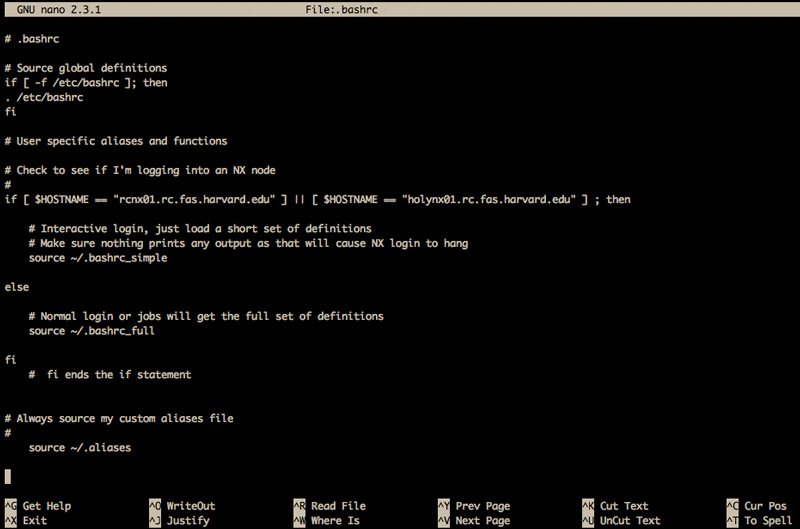How To Change .bashrc File In Windows
Why modify your .bashrc?
There may come a time when you want to customize your default login environment. If you always load the same module when logging in, or want to add together other definitions for your login shell to procedure, that ways editing the .bashrc file in your dwelling directory. This runtime configuration file is processed (or 'sourced') by fustigate, the default shell on the FASRC cluster, when you lot log into a node and by your jobs when they run. Whatsoever fourth dimension a new shell is created by your user, this file is sourced.
As you might imagine, you need to be very careful not to break your .bashrc or you may not be able to log in. If that should happen, contact usa and we can copy in a default .bashrc for you and so you're able to log in over again.
The default FASRC .bashrc file contains the following:
# .bashrc # Source global definitions if [ -f /etc/bashrc ]; then . /etc/bashrc fi # User specific aliases and functions
Afterward the # User specific aliases and functions department is where yous should put any customizations of your .bashrc as that will cause them to run after the global definitions have been sourced.The# Source global definitions section is where the default cluster-broad definitions are sourced. The /etc/bashrc file includes definitions necessary to brand your jobs and other interactions run properly across the cluster. Please do not remove this section equally you will encounter problems as a issue.
For instance, your .bashrc may contain the old module definitions calls. If you see source new-modules.sh, that's what that is. You can exit or remove is every bit it'southward benign, but nosotros recommend removing it to avoid whatsoever defoliation.
Editing your .bashrc
In order to edit your .bashrc, you'll demand to be comfy with a command-line editor such as nano (probably the easiest to get started with) or vim (aka vi). You may also be able to edit the file using your SFTP client of selection, but experiences may vary. We'll assume here that you're using nano.
From a login or other node on the cluster, blazon nano ~/.bashrc to open the file in the nano editor. My .bashrc has already been added to, and so you lot'll see additional definitions beneath the# User specific aliases and functions section.

Let'south await at what those additions do and how they fit into the larger fustigate login environment. And nosotros'll add together one more.
# .bashrc # Source global definitions if [ -f /etc/bashrc ]; then . /etc/bashrc fi > THE USER'S DEFINITIONS
# User specific aliases and functions
>> MY Code TO CHECK WHETHER I'M LOGGING INTO A SPECIFIC SERVER
# Cheque to see if I'one thousand logging into a particular node
#
if [ $HOSTNAME == "somenode01.rc.fas.harvard.edu" ] || [ $HOSTNAME == "somenode02.rc.fas.harvard.edu" ] ; then
>> IF YES, THEN SOURCE A SHORT Prepare OF Boosted DEFINITIONS
# Interactive login, just load a brusque gear up of definitions
# Make sure nothing prints whatsoever output as that volition cause SFTP to hang
source ~/.bashrc_simple
else
>> IF NO, So SOURCE MY Full Ready OF DEFINITIONS (MODULES, etc.)
# Normal login or jobs will become the total ready of definitions
source ~/.bashrc_full
fi
# fi ends the if statement
>> Washed. FI IS THE Bash Control THAT TERMINATES AN IF STATEMENT
>> I HAVE A SET OF ALIASES THAT I ALWAYS Desire SOURCED NO Affair WHERE I LOG IN
# Ever source my custom aliases file terminal
#
source ~/.aliases
>> Let'S SAY I WANT TO ALWAYS LOAD THE GIT MODULE REGARDLESS OF WHERE I LOG IN
>> Y'all CAN ADD A MODULE LOAD Argument AT THE Terminate (Non RECOMMENDED)
# Always load the git module when I log in
#
module load git
>> Merely IT'Due south Improve TO PUT ALL YOUR MODULE LOADS INTO A Role
>> And then Any TIME You lot Demand TO LOAD THEM ALL, YOU SIMPLY Telephone call THE Function
# Load my module favorites by invoking 'mymodules'
#
function mymodules {
module load git
module load Anaconda/five.0.1-fasrc01
}
Yous're free to experiment with your .bashrc, merely please exercise remember that you can intermission your admission while doing and then. A skillful practice to mitigate this is to open two shells earlier editing your .bashrc and so that, if yous break your login environment, you're still logged into that other shell (.bashrc is only sourced on login, and then that vanquish will be 'normal') and can likely set up or revert the harm from there. It's a good idea to brand a copy of your working .bashrc first earlier editing information technology.
If SFTP is declining considering your .bashrc causes output to STDOUT (echo, etc.)
You can try wrapping your interactive needs inside a statement that tests for an interactive beat out. This may not work 100% of the fourth dimension:
if [ -z "$PS1" ]; then
# not-interactive stuff, if any, here
else
# interactive stuff here
fi
Portal Module Search
Intro to Software on the FASRC cluster
Source: https://docs.rc.fas.harvard.edu/kb/editing-your-bashrc/
Posted by: betheareephy.blogspot.com

0 Response to "How To Change .bashrc File In Windows"
Post a Comment